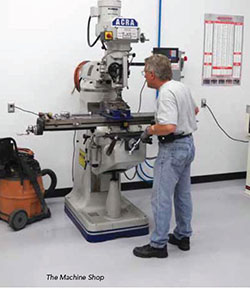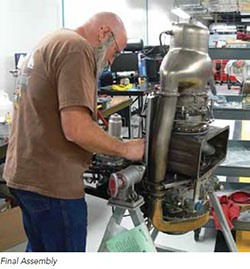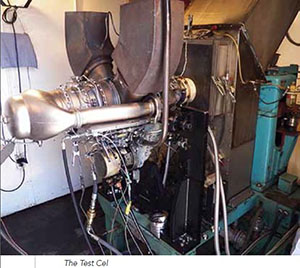
From Malta in the Mediterranean To Mesa, Ariz., in the United States

Aeromaritime America Inc. (AAI), located at Falcon Field Airport in Mesa, Ariz., is a Rolls-Royce authorized maintenance, repair and overhaul center (AMROC) specializing in the Model M250 series engines. Aeromaritime has more than 34 years of experience with an excellent reputation for providing repair, overhaul and complete support services for a wide variety of helicopter/aircraft engines. Today the company is a member of Industria de Turbo Propulsores S.A. (ITP Group), which has in-service and support facilities in Malta, Spain, the United Kingdom, and the U.S. ITP is a designated overhaul facility (DOF) for the Pratt & Whitney PW206A/B/B2/C/E and PW207C/D/E engines since 2004. AAI’s latest capabilities include on-site field service and rentals for the PW200 in America.
AAI has been the recipient of 11 Rolls-Royce Corporation awards since 2003, including total quality, family teamwork, most improved, and six customer satisfaction awards.
AAI´s technicians, inspectors and management personnel are some of the most highly experienced in the industry. Most current technicians, inspectors and the majority of management personnel hold an FAA A&P and/or repairman certificate. The average technician/inspector level of experience is more than 15 years in the aerospace industry, with the majority of those being spent within the Rolls-Royce engine family at Rolls-Royce authorized facilities.
With these credentials, I thought AAI would be a great place to get the answers to some of the more common problems found during the repair and overhaul of the Rolls Royce M250 series engines.
HeliMx – What is Aeromaritime America Inc. as a company?
AAI –Aeromaritime America Inc. provides repair, overhaul and testing services for Rolls-Royce M250 series engines in the United States. It offers engine/module receiving inspection, disassembly, cleaning, inspection, assembly, testing, and preparation for shipment services.
The company serves operators, the military and municipalities. Aeromaritime America Inc. was formerly known as Aeropower Resources Inc. and changed its name to Aeromaritime America Inc. in January 2001. The company was founded in 1971 and is based in Mesa, Ariz. As of March 7, 2008, Aeromaritime America Inc. operates as a subsidiary of Industria de Turbo Propulsores S.A.
HeliMx– Approximately how many engines have you overhauled or repaired to date?
AAI –Since our inception, there have been roughly 4,000 engines and modules (combined) that have passed through the shop.
HeliMx – What are the most common problems you see when the engines come into your shop?
AAI –Burnt combustion liners. This can be caused by streaking fuel nozzles. It also can affect your shaft horsepower (SHP), and generally causes damage to other components when not addressed.
Carbon build up. This can be hard to put a finger on an exact cause. Not completing a two-minute cool down, failure to clean struts at recommended intervals, choice of oil ... any of these will contribute to the problem.
Lack of compressor wash. Dirty compressors lead to very costly fixes down the road. It lowers engine efficiency and sets up a home for corrosion to pit the compressor wheels.
Using RTV as a fix all. If it’s broken, RTV will not provide a proper seal. The fix is not to grab a tube of RTV. Fix the problem, don’t cover it up unless it’s to get it back to a location to complete the proper fix. RTV traps moisture and can clog
oil ports.
HeliMx – Do you have recommendations as to upgrades and why? Explain the cost-to-benefit scenario.
AAI –Upgrades to the M250 Series engine would be done in accordance with a CEB or AD. There are no aftermarket solutions that provide an “upgrade” to the engine.
Barrier filters would be a highly recommended upgrade to any operator. Fine dust and dirt erodes the engine and its performance. This can be very expensive when you are replacing impellers at half life.
HeliMx – What can an operator do to prolong the life of the engine?
AAI –Compressor washes. Follow the scheduled maintenance recommendations, use third-generation engine oils, check engine for leaks with a black light, and check engine for air leaks by hand.
Attend symposiums, training and schools that broaden your knowledge of the product you are maintaining.
HeliMx – Any maintenance tips you care to pass on, like things to do and not to do?
AAI –Pick up the phone. We are always willing to help an operator or mechanic diagnose their problems. Without a particular issue, it’s hard to say what the tip may be. Using a black light to track down an oil leak would be one that most people are not aware of when they come to our shop. Turbine oil will glow purple when a black light is passed over it.
HeliMx – Run through the typical repair cycle you perform, from the engine coming into your shop to being shipped back to the customer.
AAI –Our system begins with the customer informing our salesperson/customer support rep of an engine, module or accessory coming into the shop for repair. Based on the information, provided, we open a “planned arrival” form. This form is filled out with the customer contact information, shipping information, engine or module part and serial numbers, type of helicopter and work requested. Special requests are also noted, for instance, a customer may request a test cell run before disassembly due to a “noise” or vibration, or whether an engine or module container will be required for inbound.
With the unit being sent in comes one of the most important items: times and cycles at removal. This information will assure a smooth process to get the unit into work. Log cards, properly filled out, are the single most important information item.
The customer is notified as soon as the unit arrives at our facility. A visual inspection is done on the shipping container and contents for any visual damage. Customer support will open a work order at this time, specifying the work scope. Updates are given to the customer every step of the way. Following teardown, cleaning and a detailed inspection, a technical estimate will be generated and sent to the customer, generally followed up with a phone call to answer any questions or concerns.
A sign off is required and the process continues. With all parts in and rework completed, assembly begins. This is followed by a full performance test if required and the engine is then prepared for shipping.
 Log cards and airworthiness approval certificates are completed, serial numbers are double checked, the test cell results are printed for the customer and the quality department releases the unit to shipping. Again, the customer is contacted to confirm shipping arrangements and followed up with an email with tracking information. In a few days, a follow up call is made to see if the customer has any additional questions or concerns.
Log cards and airworthiness approval certificates are completed, serial numbers are double checked, the test cell results are printed for the customer and the quality department releases the unit to shipping. Again, the customer is contacted to confirm shipping arrangements and followed up with an email with tracking information. In a few days, a follow up call is made to see if the customer has any additional questions or concerns.
There you have it, from the Mediterranean Sea to the Arizona desert, it’s some good engine information from a company in the know.
